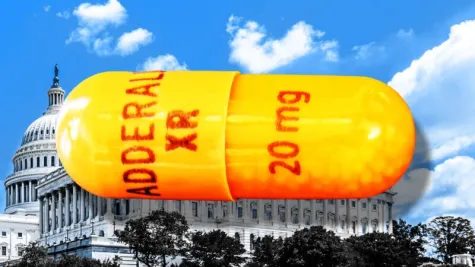
By: Patrick Hussey, PharmD, MBA
FDA Announces Shortage of Adderall
On October 12th, the FDA announced that there is a shortage on Adderall. Amphetamine mixed salts, or its brand name of Adderall, is a popular attention deficit hyperactivity disorder (ADHD) and narcolepsy drug. Reports of the shortage surfaced in early September, but the FDA has only recently recognized it as a drug shortage. Drug shortages can occur for many reasons. The FDA works closely with drug manufacturers to help prevent and reduce the impact of shortages when they occur. The FDA also works to prioritize drug shortages when the drug is considered medically necessary. Medically necessary means the drug is typically one that treats a serious condition where there are no alternative drugs available. On an annual basis, drug shortages can range anywhere from 40 to 100 drugs that make the list.
Why This Shortage is Different than Most
First, manufacturers are citing lack of labor as the main driver of the shortage. Teva, the largest supplier of Adderall in the U.S. cited this as the main source of the shortage back in August. Labor shortages seem like they could be the most reasonable cause of a drug shortage. However, when we reflect on the main cause of labor shortages and supply chain issues, it continues to be tied back to a root cause: the COVID-19 pandemic.
The pandemic brought about a sharp increase in prescriptions for Adderall and for similar medications. Adderall is a level two controlled substance, like oxycodone, hydrocodone, and morphine. As businesses shut down and in-person contact was frowned upon, regulators adjusted telehealth restrictions to allow controlled substances to be prescribed without an in-person medical evaluation. Online medical startups took off, and a subset of those focused just on ADHD drugs, like Adderall. With manufacturers being held to strict quotas on controlled substances, and a sharp increase in demand, a shortage in supply was inevitable.
Prescribers and pharmacists know that while obviously needed and well intentioned, regulations around prescribing and altering controlled substance prescriptions can cause a headache. Now we add in a drug shortage on an incredibly popular controlled substance during a pandemic, and the headache becomes a migraine.
Parents with kids taking Adderall are struggling to cope. Adults, some of whom have been taking this medication for a decade, describe going cold turkey off Adderall as feeling like their entire lives have been compromised. Patients depend on this medication. And so, if you feel like the Adderall shortage is more popularized than most, that’s because it is.
I have patients on Adderall, what do I need to know?
As providers, it’s important to guide your patients through this with the best short-term solutions possible.
Let’s start with the pharmacy. It’s important to know when and where a pharmacy and pharmacists can help. Here are some important things to note about pharmacy’s and their supply of Adderall:
- There isn’t a great way to know if a pharmacy has a specific dose of Adderall in stock. Calling a pharmacy is an option for prescribers and patients, but pharmacists are wary about giving out information on what controlled substances they are currently carrying.
- Pharmacies can be hesitant to dispense medications that are in short supply to patients that don’t typically use their pharmacy. They try to reserve their supply for their regular patients who are on a regular refill cycle.
- Pharmacies don’t typically carry medications, or doses, if they don’t currently have any patients on that medication or dose. If a pharmacy only has patients taking 20mg Adderall doses, they aren’t inclined to keep 5mg or 10mg in stock.
- Federal law doesn’t allow pharmacists to change anything on a schedule two substance prescription. Meaning, if a prescriber writes for 10mg Adderall tablets and the pharmacy only has 5mg tablets, it will require a new prescription to fill that dose.
What about alternatives in the short term? There are some alternatives to Adderall that providers might consider.
- Ritalin (generics available but typically seen as less effective) and Vyvanse (brand only but expensive) could be acceptable but may still not be suitable for your patient. When it comes to Ritalin (methylphenidate) versus Adderall (amphetamine), roughly 85% of patients will achieve symptom control using amphetamine or methylphenidate. Both medications work in similar ways in the brain and have similar side effects. The primary difference is that Ritalin works quickly and reaches peak performance earlier than does Adderall, which stays in the system longer.

- It seems like extended-release formulations are being spared more than instant release formulations. Consider a change to an ER formulation if available.
- Most IR forms of Adderall come as tablets and can be split in half where needed to create the desired dose.
What’s next?
There are many experts saying that the shortage should be resolved in the next few months, but we also heard that in August when this shortage first presented itself, and here we are. There isn’t a reason to think that this will be long term, but for patients, and parents of patients, with ADHD that doesn’t provide relief.
Expected recovery times for manufacturers’ supplies of the prescription vary. Teva Pharmaceuticals, which sells the most Adderall in the U.S., has a 10 mg dosage of Adderall that is expected to rebound in October. But many of its generic brand offerings aren’t expected to recover until March 2023.
Providers can expect to devote some more energy towards patients on Adderall prescriptions for the foreseeable future. This could include fielding more requests to change prescriptions to what is available at their local pharmacy. Office staff should expect to be receiving more calls than usual regarding these prescriptions and they should be educated on some of guidance noted above. Additionally, there can oftentimes be a stigma felt by a patient associated with controlled prescriptions. It may be helpful to let your staff know about the current shortage, especially staff who answer the phones. They should be able to convey a feeling of understanding towards a patient or their family member.
Until this shortage is resolved, providers and pharmacists should have regular conversations with their patients to help navigate continued disruptions in supply.
Prescribers can check the FDA and ASHP shortages list on a regular basis for information regarding this shortage and others.
About the Author
Patrick Hussey, PharmD, MBA currently serves as the Director of Pharmacy at Symbria Rx Services. He has 10+ years’ experience in both retail and long-term care pharmacy settings, with a focus on operations and leadership.
The opinions expressed in this post are his own and do not reflect those of Symbria, or its employees.
Connect with Patrick on LinkedIn

